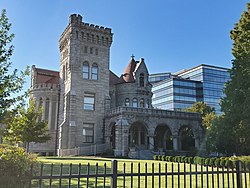
The Ku Klux Klan, commonly shortened to the KKK or the Klan, is the name of several historical and current American white supremacist, far-right terrorist organizations and hate groups. According to historian Fergus Bordewich, the Klan was "the first organized terror movement in American history." Their primary targets, at various times and places, have been African Americans, Jews, and Catholics.

The United Daughters of the Confederacy (UDC) is an American neo-Confederate hereditary association for female descendants of Confederate Civil War soldiers engaging in the commemoration of these ancestors, the funding of monuments to them, and the promotion of the pseudohistorical Lost Cause ideology and corresponding white supremacy.

Stone Mountain is a quartz monzonite dome monadnock and the site of Stone Mountain Park, 16 miles (26 km) east of Atlanta, Georgia. Outside the park is the small city of Stone Mountain, Georgia. The park is the most visited tourist site in the state of Georgia.
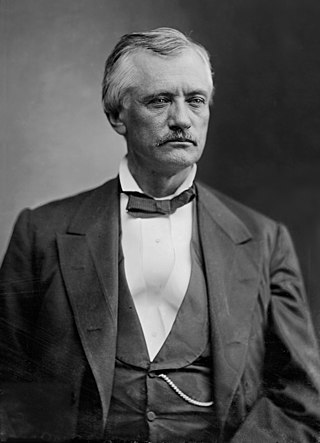
John Tyler Morgan was an American politician who was a brigadier general in the Confederate States Army during the American Civil War and later was elected for six terms as the U.S. Senator (1877–1907) from the state of Alabama. A prominent slaveholder before the Civil War, he became the second Grand Dragon of the Ku Klux Klan in Alabama during the Reconstruction era. Morgan and fellow Klan member Edmund W. Pettus became the ringleaders of white supremacy in Alabama and did more than anyone else in the state to overthrow Reconstruction efforts in the wake of the Civil War. When President Ulysses S. Grant dispatched U.S. Attorney General Amos Akerman to prosecute the Klan under the Enforcement Acts, Morgan was arrested and jailed.

John Brown Gordon was an attorney, a slaveholding planter, general in the Confederate States Army, and a politician in the postwar years. By the end of the Civil War, he had become "one of Robert E. Lee's most trusted generals."

George Washington Gordon was a general in the Confederate States Army during the American Civil War. After the war, he practiced law in Pulaski, Tennessee, where the Ku Klux Klan was formed. He became one of the Klan's first members. In 1867, Gordon became the Klan's first Grand Dragon for the Realm of Tennessee, and wrote its "Precept," a book describing its organization, purpose, and principles. He was also a member of the United States House of Representatives for the 10th congressional district of Tennessee.

The Georgia Trust for Historic Preservation is the United States' largest statewide, nonprofit preservation organization with more than 8,000 members. Founded in 1973 by Mary Gregory Jewett and others, the Trust is committed to preserving and enhancing Georgia's communities and their diverse historic resources for the education and enjoyment of all.

Westview Cemetery, located in Atlanta, Georgia, is the largest civilian cemetery in the Southeastern United States, comprising more than 582 acres (2.36 km2), 50 percent of which is undeveloped. The cemetery includes the graves of more than 125,000 people and was added to the Georgia Register of Historic Places in 2019 and the National Register of Historic Places in 2020.

The historic 21-story Rhodes–Haverty Building was, at the time of its construction in 1929, the tallest building in Atlanta, Georgia. Designed by Atlanta architects Pringle and Smith, the building was built by furniture magnates A. G. Rhodes of Rhodes Furniture and J. J. Haverty of Havertys. It remained the tallest building in Atlanta until 1954.

The U.S. Post Office Building in Selma, Alabama, also known as the Federal Building or United States Courthouse.
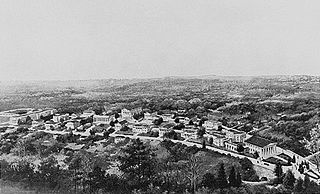
Lanier University was a short-lived private university, located in today's Morningside-Lenox Park neighborhood of Atlanta, Georgia, in the United States. It was notable for its connections with the second Ku Klux Klan, which was also based in Atlanta and which owned the university for a time.

Camak House, at 279 Meigs Street, Athens, Georgia, was built in about 1834 by James Camak and featured in Georgia's early railroad history. An example of Federal architecture, it has a number of features unusual for its period, including a kitchen within the raised basement, and closets. Both main floors have four rooms; the stairwell has a mahogany railing, and moldings and trim were made using a Greek key pattern. After long service as a family home, it was used as a Masonic Lodge before being bought by Coca-Cola Enterprises. In 1975 Camak House was listed on the National Register of Historic Places, but the building had by then fallen into disrepair. It was restored and used as the offices of a law firm. As of December 2011, it is for sale.
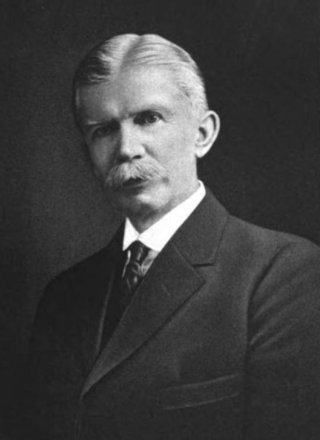
The Venable Brothers was a business venture formed by brothers William Hoyt Venable (1852–1905) and Samuel Hoyt Venable (1856–1939) in DeKalb County, Georgia. The brothers owned rock quarries. Sam Venable was involved in the resurgence of the Ku Klux Klan and in the creation of the Confederate memorial on Stone Mountain, Georgia. He owned Stone Mountain, where a cross burning was held in 1915, and granted the Klan an easement to the mountain in 1923. The Venable brothers granted a 12-year lease to Stone Mountain for the carving of the Confederate memorial carving started by Gutzon Borglum.
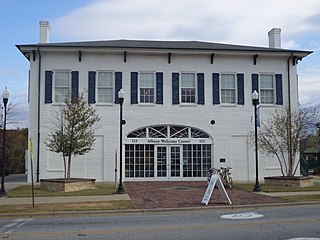
The Albany Welcome Center, formerly known as the Bridge House, is a historic residential building in Albany, Georgia. It was designed by African American architect and engineer Horace King and built in 1858. It was added to the National Register of Historic Places on November 19, 1974. It is located at 112 North Front Street.

William Laurence Saunders (1835–1891) was an American attorney, newspaper editor, historian, Ku Klux Klan chief organizer in North Carolina, and the North Carolina Secretary of State from 1879 until his death in 1891.

Caswell County Courthouse is a historic county courthouse located in Yanceyville, Caswell County, North Carolina. It was built between 1858 and 1861, and is a rectangular two-story, stuccoed brick building, five bays wide and seven deep. It sits on an elevated granite block foundation and features a two-level recessed entrance porch and octagonal cupola.
Thomas Housch Benton is an American Republican politician who served in the Georgia House of Representatives from the 31st district from 2005 to 2023. He has been repeatedly criticized for neo-Confederate comments.

Laura Martin Rose, known professionally as Mrs. S. E. F. Rose, was a historian and propagandist for the Ku Klux Klan employed by the United Daughters of the Confederacy.
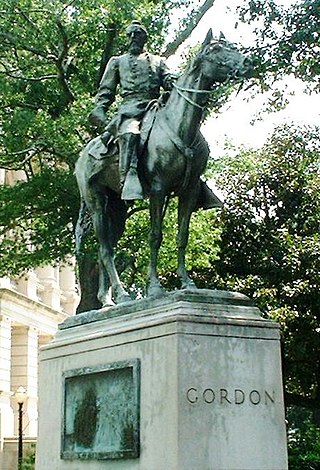
The equestrian statue of John Brown Gordon is a monument on the grounds of the Georgia State Capitol in Atlanta, Georgia, United States. The monument, an equestrian statue, honors John Brown Gordon, a general in the Confederate States Army during the American Civil War who later become a politician in post-Reconstruction era Georgia. Designed by Solon Borglum, the statue was dedicated in 1907 to large fanfare. The statue has recently become a figure of controversy over Gordon's racist views and associations with the Confederacy, with some calling for its removal.
